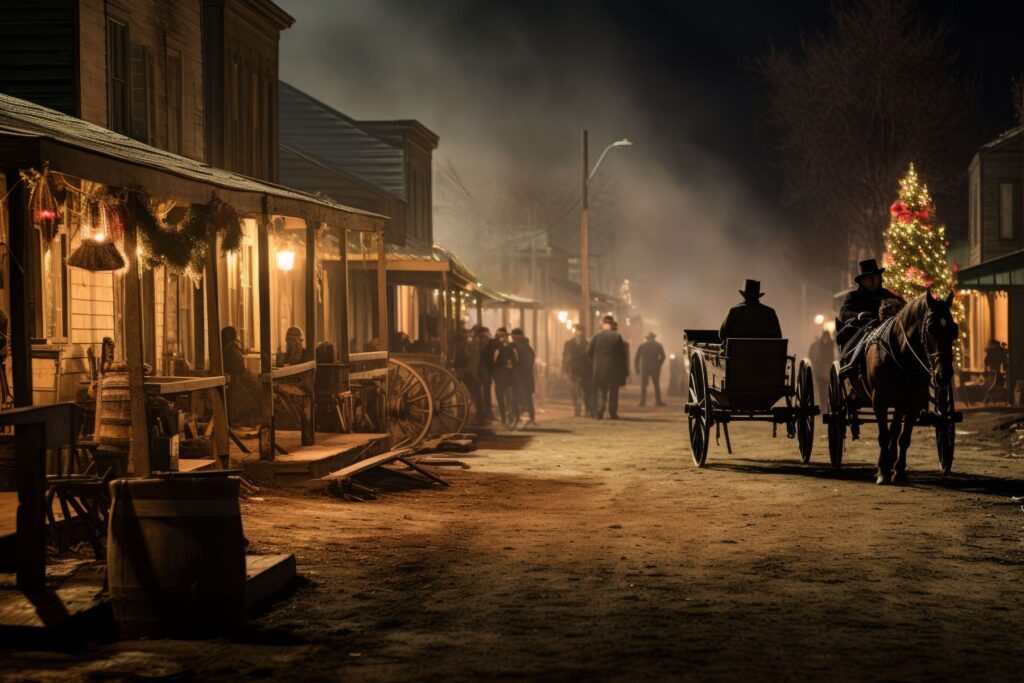By Karey McCann

Did you ever wonder what it was like to be a kid at Christmas 100 years ago?
Indoor shopping malls didn’t exist in 1924, and the Internet sure wasn’t around! Amazon was – and still is – not only he largest river in South America, but also in the whole world. And it certainly was not a place to shop, unless you’re in the market for piranha. Those are the freaky fish that will eat ANYTHING (including you) that ventures into the Amazon River.
Some Christmas presents back then were homemade. For instance, a fancy embroidered handkerchief or doll bed for a girl. Boys might get a homemade slingshot or a carved wooden train. Raggedy Anne and Andy cloth dolls would be either homemade or bought though a mail order service, as were other gifts such as roller skates, kiddie cars and harmonicas. Lincoln Logs, crayons, marbles and jacks, and a red Radio Flyer wagon were also kid favorites.
Ackers Book Store and Bashford Burmeister in Prescott were popular places to shop for Christmas presents 100 years ago, and they still are today.
Candy, such as bonbons or a Whitman’s chocolate sampler, nuts and a fresh apple or orange were common stocking stuffers in the 1920s. Back then, fresh fruit was an uncommon luxury.
Christmas stockings themselves were not the often large, specially decorated type kids today are used to hanging up on a bedpost or from a fireplace mantel. In the 1920s, a Christmas stocking was your own sock. So you had to make sure it was a clean one before you hung it up for Santa!
Christmas wrapping paper was used, as it is now. Though Christmas cards hadn’t yet become a tradition. Instead, people usually bought Christmas stationary. They would send out lengthy letters to far-away friends and relatives, updating them on all that had occurred with the family that year. People didn’t get mail every day, or even often, back then. So getting a Christmas letter was really special.
People in Yavapai County typically didn’t buy Christmas trees in the 1920s. Instead, they cut down a tree on their own property. If a person didn’t have a spare Christmas kind of tree on their land, they could get a free permit from the Forestry Service that showed them areas where it was okay to cut one down.
As for decorations, Christmas trees were dressed with lights, tinsel and ornaments much as they are today. Some people back in the 1920s, like my grandparents, had electricity but preferred the softer, prettier glow of tallow candles to light the Christmas tree. That is, until the year the Christmas tree caught fire at the top! Quickly, my grandfather grabbed the tree by the base of the trunk and threw it out of the front door – decorations and all!
Fortunately, no one was hurt. Needless to say, after that my grandparents preferred to use the safer electric Christmas lights.
Even 100 years ago, the courthouse in Prescott was decorated with Christmas lights. Not as many as today, but it still was pretty. The big tree on the courthouse plaza was lit on Christmas Eve, and people of the town gathered to attend a church service and sing Christmas songs. We still do that today.
You will be familiar with some Christmas dinner food served in the 1920s. Others you will not have heard of and possibly say: “Ewww!”
Ham or roast turkey with gravy and cranberries, and the usual fixings remains a traditional Christmas meal. But how about roast ostrich with oyster sauce? Tomato soup or creamed peas? You will be relieved to learn you would still have survived Christmas dinner as a kid in the 1920s, because macaroni and cheese was as popular then as it is now!
In keeping with the Christmas spirit, Prescott began putting together dinner baskets for needy families in 1916. During the 1920 Christmas season, the city handed out large baskets of food and other necessary items to 42 families. This may not seem like a lot of families, but in 1920 Prescott had a population of 5,010 compared with 47,757 today. Plus most people then did not have the financial resources we have today. That made their generosity even more meaningful.
Giving at Christmas remains a tradition. You can check with your parents to find out what your church, local civic groups and charities are collecting this year to help families in need. It will make you feel good to know you helped some other kids have a better Christmas.
So what would you like from Santa? No matter 100 years ago or now, it is fun to be a kid on Christmas!
Sources: Sharlot Hall Museum, 1924 Journal Miner Newspaper, True Tales of Prescott
